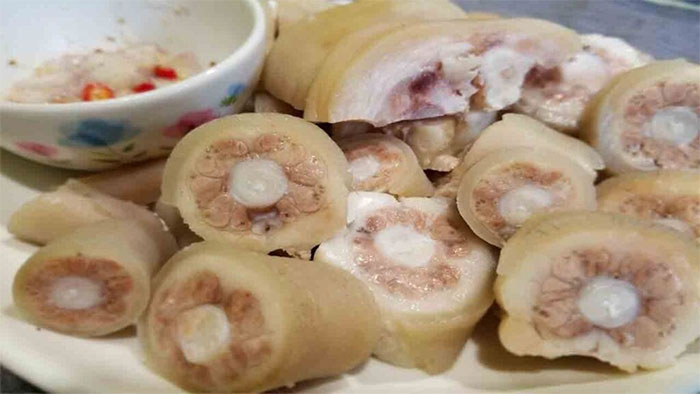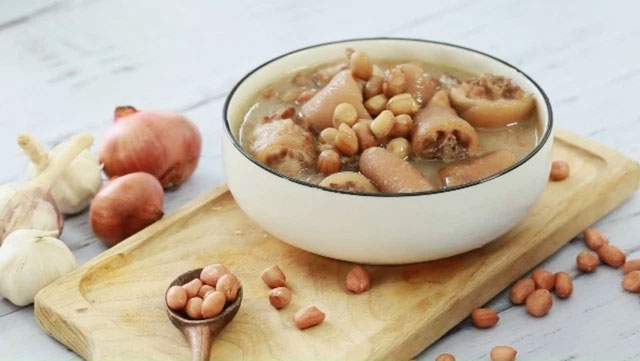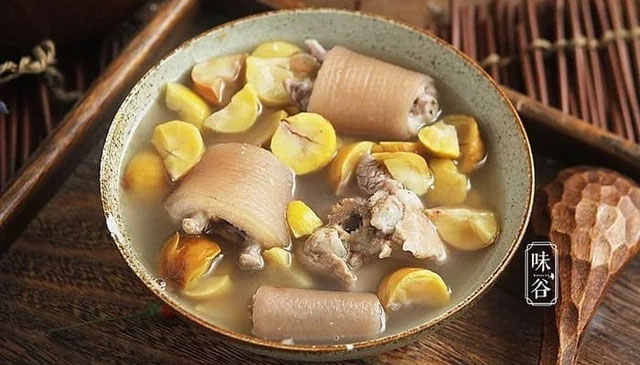The precious part of the pig we are discussing is: The pig’s tail.
Benefits of Pig Tails That Not Everyone Knows
The pig’s tail is also one of the most valuable parts of the pig. Each pig only has one small tail, so not everyone can purchase this part; many shop owners even keep this nutritious part to take home and enjoy.
The pig’s tail is chewy and has a natural sweetness, making it a versatile ingredient for many delicious dishes that nourish the body. According to traditional medicine, pig tails are believed to enhance qi, nourish blood, and support conditions such as kidney deficiency, erectile dysfunction, and premature ejaculation… Despite being so nutritious, not everyone is aware of all its wonderful benefits.

The pig’s tail mainly consists of skin, cartilage, and tendons…
What benefits does the pig’s tail bring for women’s skin and men’s physiology?
1. Provides abundant collagen for women
The pig’s tail is primarily made up of skin, cartilage, and tendons, all of which contain a significant amount of collagen. As women age, they tend to experience a decrease in collagen, leading to signs of aging. Consuming pig tails helps replenish collagen in the body, slowing down the process of skin wrinkling, dryness, and promoting a brighter, more elastic, and resilient complexion.
Moreover, the fat content in pig skin is not as high as in pork meat, so it does not cause rapid weight gain if consumed in moderation.
2. Helps women achieve firmer breasts
Having a healthy and firm bust is a major concern for women. If you want to enjoy a dish that can improve sagging breasts, you should not overlook pig tails, as they are rich in protein that helps build muscle, firm up tissue, and enhance breast shape. Additionally, the abundant collagen in pig tails promotes breast development, making them fuller and rounder.

Pig tails also contain calcium phosphate, osteomucin, and collagen…
3. Promotes bone growth in children
During their growth and development phase, parents often worry that their children may not achieve optimal bone growth. In this case, parents can introduce pig tails into their children’s diet because the bone marrow components found in them can strengthen bones and promote their development.
Additionally, pig tails contain calcium phosphate, osteomucin, and collagen, all of which are crucial for improving the metabolic processes of bone cells, helping children develop their bones to the best potential.
4. Prevents osteoporosis in the elderly
As people age, their bones weaken, leading to the onset of osteoporosis. Instead of worrying too much, you should consider adding pig tails to your weekly menu, as the bone marrow in the tail contains many minerals that can enhance bone health and prevent calcium deficiency. They also provide excellent support for back pain caused by fatigue or the symptoms experienced by women during the postpartum period.
5. Protects the lower back
Pig tails are rich in minerals, particularly calcium and iron, which can supplement the body with essential nutrients, helping to prevent osteoporosis and anemia.
6. Nourishes the kidneys and benefits essence
In traditional Vietnamese medicine, there is a recipe using pig tails that is said to nourish the kidneys and benefit essence.
Recipe: Use 100g of pig tails, a piece of dried tangerine peel, 10 shelled walnuts, 10 peanuts, and some salt. Clean the pig tails and cut them into short pieces. Boil water, then add the pig tails, tangerine peel, walnuts, and peanuts, cover, reduce heat, and simmer until tender; serve hot.

People with high blood pressure, heart conditions, or obesity should eat as little as possible.
Note When Eating Pig Tails
Most people can eat pig tails, except for those with high blood pressure, heart conditions, or obesity, who should consume them as little as possible. The fat in pig tails contains a lot of cholesterol, which can worsen these conditions. It is advisable to eat pig tails only once a week and not to overindulge.


















































